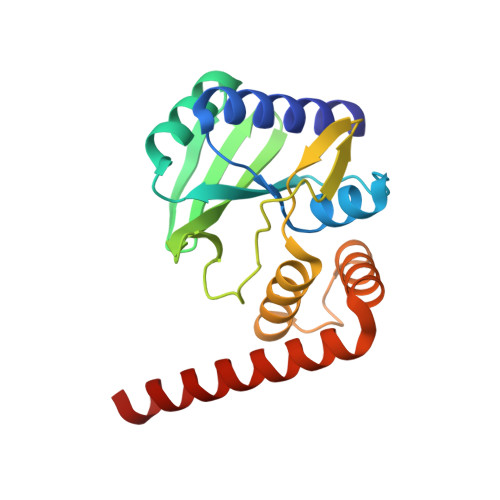Effect of solvent and protein dynamics in ligand recognition and inhibition of aminoglycoside adenyltransferase 2′′-Ia.
Bacot-Davis, V.R., Bassenden, A.V., Sprules, T., Berghuis, A.M.(2017) Protein Sci 26: 1852-1863
- PubMed: 28734024
- DOI: https://doi.org/10.1002/pro.3224
- Primary Citation of Related Structures:
5KQJ - PubMed Abstract:
The aminoglycoside modifying enzyme (AME) ANT(2″)-Ia is a significant target for next generation antibiotic development. Structural studies of a related aminoglycoside-modifying enzyme, ANT(3″)(9), revealed this enzyme contains dynamic, disordered, and well-defined segments that modulate thermodynamically before and after antibiotic binding. Characterizing these structural dynamics is critical for in situ screening, design, and development of contemporary antibiotics that can be implemented in a clinical setting to treat potentially lethal, antibiotic resistant, human infections. Here, the first NMR structural ensembles of ANT(2″)-Ia are presented, and suggest that ATP-aminoglycoside binding repositions the nucleotidyltransferase (NT) and C-terminal domains for catalysis to efficiently occur. Residues involved in ligand recognition were assessed by site-directed mutagenesis. In vitro activity assays indicate a critical role for I129 toward aminoglycoside modification in addition to known catalytic D44, D46, and D48 residues. These observations support previous claims that ANT aminoglycoside sub-class promiscuity is not solely due to binding cleft size, or inherent partial disorder, but can be controlled by ligand modulation on distinct dynamic and thermodynamic properties of ANTs under cellular conditions. Hydrophobic interactions in the substrate binding cleft, as well as solution dynamics in the C-terminal tail of ANT(2″)-Ia, advocate toward design of kanamycin-derived cationic lipid aminoglycoside analogs, some of which have already shown antimicrobial activity in vivo against kanamycin and gentamicin-resistant P. aeruginosa. This data will drive additional in silico, next generation antibiotic development for future human use to combat increasingly prevalent antimicrobial resistance.
Organizational Affiliation:
McGill University, Biochemistry, 3649 Promenade Sir William Osler Room 470, Montreal, QC H3A 0G4, Canada.














